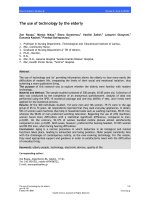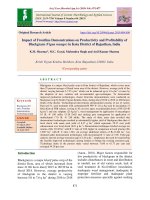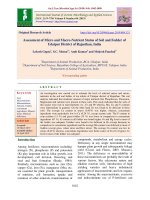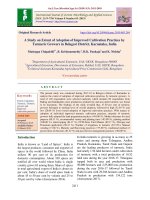Adoption of mungbean production technology by the farmers in Jaipur district of Rajasthan, India
Bạn đang xem bản rút gọn của tài liệu. Xem và tải ngay bản đầy đủ của tài liệu tại đây (167.33 KB, 5 trang )
Int.J.Curr.Microbiol.App.Sci (2017) 6(4): 739-743
International Journal of Current Microbiology and Applied Sciences
ISSN: 2319-7706 Volume 6 Number 4 (2017) pp. 739-743
Journal homepage:
Original Research Article
/>
Adoption of Mungbean Production Technology by the
Farmers in Jaipur District of Rajasthan, India
Mukesh Choudhary1*, Hanuman Lal Jat1, Seeta Bijarniya2 and Vidya Bhati3
1
Department of Extension Education, Sri Karan Narendra College of
Agriculture, Jobner (Rajasthan)-303329, India
2
SRF D.E.E. SKNAU, Jobner, India
3
Department of Horticulture, SKRAU Bikaner, India
*Corresponding author
ABSTRACT
Keywords
Mungbean,
Adoption,
Production,
Technology.
Article Info
Accepted:
06 March 2017
Available Online:
10 April 2017
Pulses are the main source of quality protein and a rich source of energy, minerals and
certain vitamins. The study was conducted in Jaipur district of Rajasthan. Jaipur district
comprises of sixteen tehsils, out of which 3 tehsils viz., Dudu, Phulera and Phagi were
selected purposely. Two gram panchayats were selected randomly from each tehsils. Two
revenue villages were selected from each selected gram panchayat on the basis of random
sampling method. Thus the total 12 villages were selected. Total 120 mungbean growing
farmers (respondents) were selected randomly through proportional allocation to the size
of sample. It was found that majority of the farmers (70.%) were in the medium adoption
group while (20.83%) farmers were in low adoption group and only (9.17%) of farmers
were in the high adoption group of mungbean cultivation and also found that the farmers
had adopted practice “Spacing” to the higher extent with MPS 71.25. The practice
“Storage” was found to be least adopted by the farmers with MPS 36.25. The study
revealed that the majority of farmers had adopted practice “Spacing” to the higher extent
and practice “Storage” was found to be least adopted by the farmers.
Introduction
Pulses are the main source of quality protein
and a rich source of energy, minerals and
certain vitamins. They help in balancing the
cereal dominated diet of low and middle
income families by supplementing the
essential amino acids profile of cereal
proteins economically.
balanced ration to the growing population of
India Mungbean is a good option because of
its high yielding potential. A quantum jump in
the production of this crop can meet the
expectations of the policy makers and
nutritional planners.
Mungbean stands third after chickpea and
pigenpea in the country among pulses. Pulses
accounts 24.79 m ha area with an annual
production of 19.77 million tons in the
country. Mungbean occupies 29.36 lakh
hectare area and contributes 12.80 lakh tones
Among the various legume crops grown in
India mungbean occupies an important place
because of its 25 percent protein excellent
quality and high digestibility due to low
flatulence (Singh et al., (1983). Providing
739
Int.J.Curr.Microbiol.App.Sci (2017) 6(4): 739-743
in pulse production in the country
(Anonymous, 2012-13). The important
mungbean growing states are Rajasthan,
Madhya Pradesh, Uttar Pradesh, Orisha,
Maharastra, Karnataka, Bihar etc.
Extent of adoption of production
technology practices of mungbean
To measure the extent of adoption on the
three point continuum schedule developed by
the investigator was used Ten package of
practices of mungbean cultivation were
included in the schedule. Some of the
practices were further divided into subquestions. Finally the adoption index was
calculated by the following formula:
In Rajasthan mungbean is grown over 790185
hectare with the production of 23426 tonnes.
Jaipur district has 60624 hectare area under
mungbean cultivation and production 9579
tonnes, which is nearly 4.09 per cent of total
mungbean
production
in
Rajasthan
(Annoymous, 2012-13).
Adoption Index =
The productivity of Jaipur district is 158
kg/ha. There is a wide scope to improve and
increase the mungbean production and
productivity by enhancing the knowledge and
adoption of recommended production
technology by farmers.
Total adoption score obtained by respondents
-------------------------------------------------x 100
Maximum attainable score
Materials and Methods
The mean and standard deviation of all the
respondent adoption scores were computed
for classifying the adoption in different
categories. Based on the mean adoption score
and standard deviation the farmers were
categorized under three adoption level
categories, namely low, medium and high
adoption level as follows:
The formula was applied for all practices,
which helped in calculating adoption index.
The study was conducted in Dudu, Phagi and
Phulera tehsils of Jaipur district of Rajasthan.
Jaipur district was selected purposely on
account of lowest productivity i.e. 158 kg/ha
and tehsils were selected purposely because
these tehsils have maximum area under
mungbean crop in Jaipur district, Farmers
were selected on the basis of proportinate
random sampling technique from each
selected village making a total sample of 120
mungbean growers.
Low adoption level
= Score below
(mean adoption – SD)
Medium adoption level
= Score from
(mean adoption - SD) to (mean + SD)
High adoption level
= Score above
(mean adoption + SD)
An interview schedule consisting of
measuring devices along with the face data of
the respondents was developed for the study
purpose and was personally introduced to the
respondents following the principles of
interviewing.
Extent of adoption of Production
Technology practices of mungbean by the
farmers
Adoption is a mental process. In recent times,
a number of innovations are being generated
by our agricultural scientists but all the
innovations are not being adopted by the
members of the social system. Adoption of an
The data so collected were tabulated and
analyzed. Interferences were drawn after
subjecting the data to statistical analysis
which led to the following findings.
740
Int.J.Curr.Microbiol.App.Sci (2017) 6(4): 739-743
innovation depends upon the knowledge of
adopters about innovations, innovativeness,
complexity, visibility and capability of
innovations. It is generally accepted that if an
individual has knowledge about different
aspects of technologies, he is likely to adopt it
with high speed and high adoption rate.
Therefore, adoption of technology becomes
the central concern for social scientists. Thus
the objective pertaining to adoption of
recommended
mungbean
production
technology included in the present
investigation.
organized by the extension field functionaries
in the villages which might help in convincing
the farmers about the recommended
technology of mungbean cultivation, which
have resulted in increasing the adoption of
recommended technology by the farmers. Still
there is an increasing recognition of the need
to convert these medium adopters into high
adopters and low adopters into medium
adopters. Therefore, all the essential supplies
and services for transfer of technology
through extension activities should be made
available to the farmers and an intensive
effort to convince the farmers about
recommended technology of mungbean is
needed. The findings of the study are in
accordance with the findings of (Solanki et
al., 2012; Singh et al., 2006 and Rahim,
2003).
To get an over view of the adoption level of
the farmers about recommended cultivation
practices of mungbean the farmers were
grouped into (i) low (ii) medium and (iii) high
adoption categories on the basis of calculated
mean and standard deviation of the obtained
adoption scores by the respondents.
Practice wise adoption by farmers about
recommended production technology of
mungbean
Overall adoption level of farmers about
recommended
production
technology
mungbean
The level of adoption of farmers was
measured for ten mungbean cultivation
practices. Efforts were made to include only
those practices which can be adopted by the
farmers practically in the field. The results
have been presented in table 2.
The findings reveal that 84 respondents
(70.00 per cent) fall in medium adoption
category, whereas, 25 respondents (20.83 per
cent) were found in low adoption and
remaining 11respondents (9.17 per cent)
possessed high adoption about recommended
cultivation practices of mungbean given in
table 1 (Sachan et al., 2005; Meena et al.,
2006 and Kumari et al., 2006).
Table 2 shows that farmers had highest
adoption about “spacing practice” in
mungbean MPS 71.25 while minimum
adoption was about “Storage” MPS 36.25.
The table further indicates that the farmers
adoption about fertilizer application, use of
high yielding varieties, sowing of seed, soil
and field preparation, harvesting, seed
treatment, weed management and plant
protection measure, were found with MPS
65.48, 62.50, 58.47, 46.80, 43.75, 43.16,
42.77 and 41.25 respectively Agarwal (2000).
It was found that majority of the respondents
(70.00 per cent) were medium adopters, 20.83
per cent were low adopters and only 09.17 per
cent of the respondents were high adopters of
recommended technology of mungbean
cultivation. It may be due to the fact that
various
extension
activities
like
demonstrations, trainings etc. are frequently
741
Int.J.Curr.Microbiol.App.Sci (2017) 6(4): 739-743
Table.1 Extent of adoption of recommended production technology of mungbean by the farmers
N = 120
S. No. Adoption categories
Number of
Percentage
respondents
1
Low (Score below 29.05)
25
20.83
2
Medium (Score from 29.05 to 37.30)
84
70
3
High (Score above 37.30)
11
9.17
= 33.18,
= 4.12
Table.2 Practice wise adoption by farmers about recommended production technology of
mungbean
N=120
S.N.
1.
2
3.
4.
5.
6.
7.
8.
9.
10.
Package of practices
Soil and field preparation
Spacing
Use of high yielding varieties
Sowing of seed
Seed treatment
Fertilizer application
Weed management
Plant protection measures
Harvesting
Storage
MPS
46.80
71.25
62.50
58.47
43.16
65.48
42.77
41.25
43.75
36.25
The farmers had over adopted the “Spacing”
and “Fertilizer application” technology. The
over adoption of “Spacing” practice might be
due to the reason that the farmers had large
size of land holding and they want to produce
more. The over adoption of “Fertilization
application” might be due to the reason that
the farmers have know the importance of
fertilizer application which resulted in highest
adoption. The farmers had poorly adopted the
practices like “Plant protection measures”,
“Weed management”, “Storage “ etc. might
be due to high cost of weedicides, insecticides
and pesticides and storage facilities. The
findings of present study are in line with the
findings of Singh (2010) and Chandawat et
al., (2012) Solanki et al., (2012).
Rank
V
I
III
IV
VII
II
VIII
IX
VI
X
adoption group and only (9.17%) of farmers
were in the high adoption group of mungbean
cultivation and also found that the farmers
had adopted practice “Spacing” to the higher
extent with MPS 71.25. The practice
“Storage” was found to be least adopted by
the farmers with MPS 36.25. The study
revealed that the majority of farmers had
adopted practice “Spacing” to the higher
extent and practice “Storage” was found to be
least adopted by the farmers.
References
Agarwal, J.K. 2000. “Knowledge and
adoption of improved pea cultivation
practices in Jaipur district of
Rajasthan”. M.Sc. (Ag.) Thesis, R.A.U.,
Bikaner, Campus: Jobner.
Annoymous. 2012-13. “Department of
Agriculture and Corporation”
In conclusion it was found that majority of the
farmers (70.%) were in the medium adoption
group while (20.83%) farmers were in low
742
Int.J.Curr.Microbiol.App.Sci (2017) 6(4): 739-743
Annoymous. 2012-13. “Vital Agriculture
statistics, Directorate of Agriculture”,
Government of Rajasthan.
Chandawat, M.S., Sharma, P.K. and Parmar,
A.B. 2012. “Extent of Adoption about
Improved Cultivation Practices of Gram
Crop and Constraints Faced by the
Farmers of Kheda District” Guj. J. Extn.
Edu., 23.
Kumari, N., Sharma, F.L. and Sharma, V.P.
2006. Adoption behaviour of garlic
growers in Chittorgarh district of
Rajasthan. Raj. J. Extn. Edu., 14: 36-40.
Meena, R.P., Sharma, C., Sharma, V.P.,
Bhimawat, B.S and Dadheech, B.S.
2006. Adoption of improved Ajwain
production practices among the farmers
of Dungla Tehsil in Chittorgarh district
of Rajasthan. Raj. J. Extn. Edu., 14: 4751.
Rahim, F. 2003. “Impact of education level
on the adoption of improved gram
cultivation practices in Tehsil Takht-iNasrati, Karak, NWFP” Sarhad J. Ag,
19(3): 413-417.
Sachan, R.C., Sharma, A.K. and Jha, S.K.
2005. “Problem and strategy for
mustard production in Bharatpur district
of Rajasthan”. Ind. Res. J. Extn. Edu.,
5(1): 18-25.
Singh, B. Chauhan, T.R. 2010. “Adoption of
mungbean production technology in
arid zone of Rajashtan”. Ind. Res. J.
Extn. Edu, Vol. 10 No. 2 pp. 73-77.
Singh, C., Singh, P., Singh, R. 1983. Modern
Technique of Raising Field Crops
Oxford and IBH Publishing, (2): 244.
Singh, N., Lal, H. and Sharma, P. 2006.
Adoption of recommended mustard
production technology by the farmers.
Raj. J. Extn. Edu., 10: 88-92.
Solanki, J., Solanki, K.D. and Mayur
Prajapati. 2012. Extent of Adoption of
Recommended Kidney Production
Technology Guj. J. Extn. Edu, 23.
Solanki, J., Solanki, K.D. and Mayur
Prajapati. 2012. Extent of Adoption of
Recommended Kidney Production
Technology, Guj. J. Extn. Edu., 23.
How to cite this article:
Mukesh Choudhary, Hanuman Lal Jat, Seeta Bijarniya and Vidya Bhati. 2017. Adoption of
Mungbean Production Technology by the Farmers in Jaipur District of Rajasthan.
Int.J.Curr.Microbiol.App.Sci. 6(4): 739-743. doi: />
743









